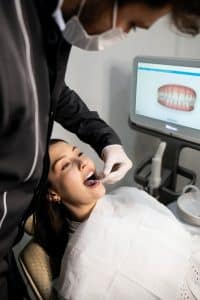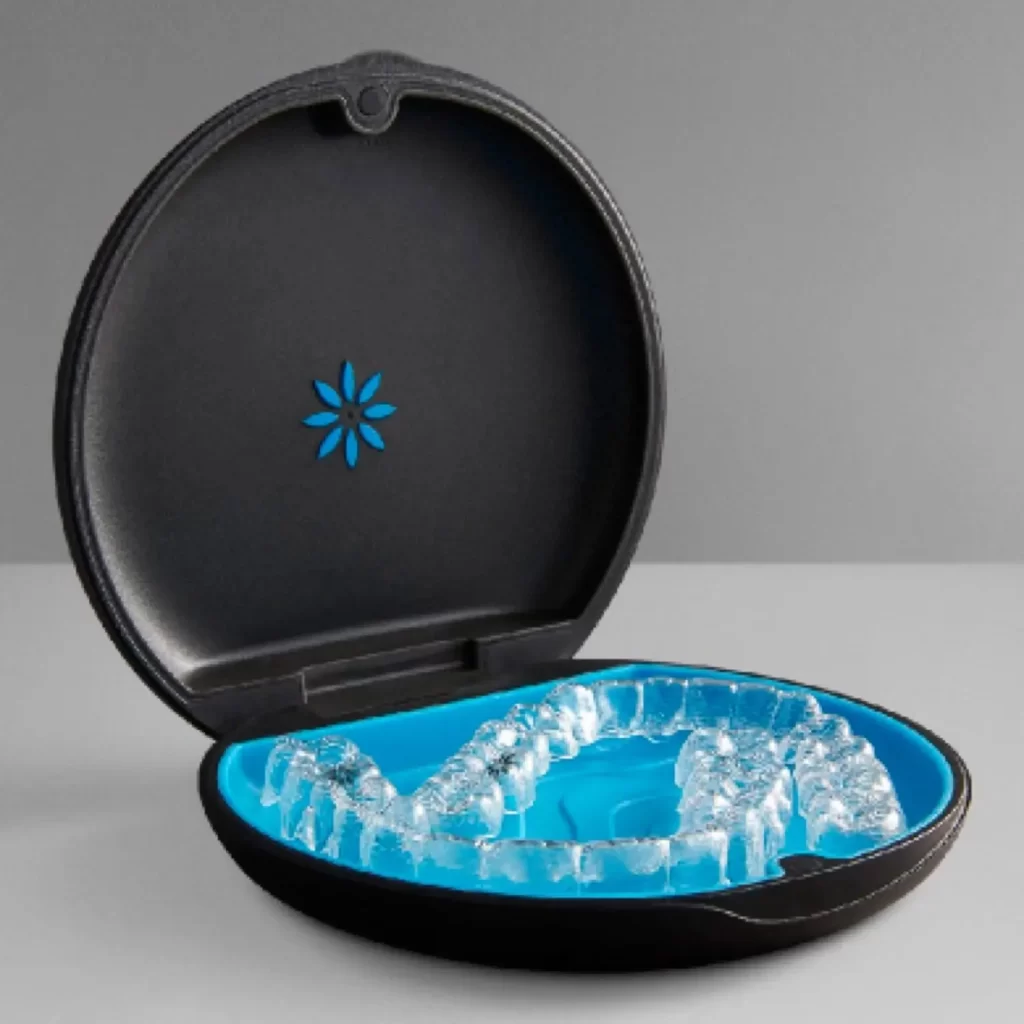Invisalign has revolutionized the way people straighten their teeth, offering a clear and comfortable alternative to traditional braces. One of the most common questions from prospective patients is, “How long does Invisalign take to work?” Understanding the treatment timeline is crucial for setting expectations and preparing for this exciting journey toward a better smile.
Understanding Invisalign

Invisalign works through a series of aligners, each slightly different from the last. Patients wear each set of aligners for about one to two weeks before moving on to the next set in the series. This step-by-step process allows for controlled tooth movement, which is both gentle and efficient.
One of the primary benefits of Invisalign is its discreet appearance. The aligners are made from a clear plastic material that is nearly invisible when worn. This makes Invisalign an attractive option for adults and teens who prefer a less noticeable orthodontic treatment. Additionally, the aligners can be removed for eating, drinking, brushing, and flossing, providing a level of convenience and flexibility not available with traditional braces.
How Long Does Invisalign Take to Work?
The duration of Invisalign treatment varies depending on the complexity of the dental issues being addressed. On average, most patients complete their treatment within 12 to 18 months. For minor adjustments, some people may see results in as little as 6 months. However, more complex cases can take up to 24 months or longer. Your orthodontist will provide a personalized timeline based on your specific needs during your initial consultation.
Factors Influencing Invisalign Treatment Duration
The length of time required for Invisalign treatment varies from person to person, depending on several factors. Understanding these factors can help you get a better idea of what to expect.
Type of Dental Issue Being Addressed
Different dental issues require varying amounts of time to correct. For instance, mild crowding or minor gaps between teeth may take less time to fix compared to more complex issues like severe crowding or significant bite problems. The type of issue you have will play a significant role in determining your treatment timeline.
Severity of the Dental Issue
The extent of the dental issue is another critical factor. Minor adjustments can be achieved relatively quickly, while more severe cases will naturally take longer. For example, slight misalignments might be corrected in a matter of months, while more severe cases could take over a year.
Patient’s Age
Age can also influence the duration of Invisalign treatment. Younger patients often experience faster results because their teeth move more easily. However, adults can still achieve excellent outcomes with Invisalign; it just might take a bit longer.
Compliance with Wearing Aligners
One of the most significant factors affecting the length of Invisalign treatment is how diligently you wear your aligners. For the treatment to be effective, patients need to wear the aligners need for 20-22 hours per day. Removing them too often or not wearing them for the recommended amount of time can prolong the treatment.
Complexity of the Treatment Plan
The overall complexity of your treatment plan, including the number of aligners required and the specific movements needed to achieve the desired results, will also impact the timeline. Your orthodontist will provide a detailed plan outlining each step of the process, giving you a clear idea of how long your treatment is expected to take.
Typical Invisalign Treatment Timeline
While the exact timeline for Invisalign treatment can vary, most patients follow a similar process. Here’s a detailed look at what you can generally expect from start to finish:.
1. Initial Consultation
Your Invisalign journey begins with an initial consultation with your orthodontist. During this visit, your orthodontist will conduct a thorough dental examination to assess your teeth and bite. This step is crucial for determining whether Invisalign is the right option for you. If it is, your orthodontist will take digital scans, photos, and X-rays of your teeth. These images are used to create a precise 3D model of your mouth, which will guide the development of your custom treatment plan.
2. Receiving the Aligners
Once your treatment plan is finalized, your custom aligners will be manufactured. This process typically takes a few weeks. Once your aligners are ready, you’ll return to your orthodontist’s office for your first fitting. Your orthodontist will ensure that the aligners fit properly and will provide instructions on how to wear and care for them.
3. Wearing the Aligners
The main phase of Invisalign treatment involves wearing your aligners every day. For optimal results, aligners should be worn for 20–22 hours per day, removing them only for eating, drinking, brushing, and flossing. Each set of aligners is typically worn for one to two weeks before moving on to the next set in the series. This gradual progression allows your teeth to move incrementally towards their final positions.
4. Regular Check-Ups with the Orthodontist
Throughout your treatment, you’ll have regular check-ups with your orthodontist, usually every six to eight weeks. These appointments are essential for monitoring your progress and making any necessary adjustments to your treatment plan. During these visits, your orthodontist will check the fit of your aligners, ensure that your teeth are moving as planned, and address any concerns you may have.
5. Completion of Treatment
Once you’ve gone through all your aligners, your treatment is nearing completion. At this stage, your orthodontist will evaluate your teeth to ensure they have moved into their desired positions. In some cases, minor adjustments are necessary, and you may receive additional aligners to fine-tune the final results.
6. Post-Treatment Retention
After completing your Invisalign treatment, maintaining your new smile is crucial. This involves wearing retainers, which help keep your teeth in their new positions. Your orthodontist will provide guidance on how often and how long you should wear your retainers. Typically, retainers are worn full-time for a few months, then nightly thereafter.
Shortening the Invisalign Timeline
While the duration of Invisalign treatment varies for each individual, there are several ways to potentially shorten the timeline. Adhering to best practices and taking proactive steps can help ensure your treatment progresses as efficiently as possible.
Importance of Adherence to the Treatment Plan
One of the most critical factors in achieving faster results with Invisalign is strict adherence to the treatment plan provided by your orthodontist. This means wearing your aligners for the recommended 20-22 hours per day without fail. Consistency is key to ensuring that your teeth move according to the planned schedule.
Tips for Wearing Aligners Consistently
To maintain the required daily wear time, it’s helpful to establish a routine. For example, make it a habit to put your aligners back in immediately after meals and brushing. Setting reminders on your phone can also be a useful strategy to ensure you don’t forget to wear your aligners.
Proper Aligner Care
Taking good care of your aligners can also contribute to a smoother treatment process. Clean your aligners regularly using a soft toothbrush and clear, mild soap. Avoid using hot water, as it can warp the plastic. Keeping your aligners clean helps maintain their transparency and prevents any potential discomfort or issues that could slow down your progress.
Avoiding Foods and Drinks That Can Stain or Damage Aligners
While wearing Invisalign, it’s essential to be mindful of the foods and drinks you consume. Remove your aligners before eating or drinking anything other than water. This not only prevents staining but also avoids the risk of damaging the aligners. After eating, brush your teeth before reinserting your aligners to maintain oral hygiene and keep your aligners clean.
Keeping Regular Appointments
Regular check-ups with your orthodontist are crucial for monitoring your progress and making any necessary adjustments to your treatment plan. Skipping appointments or delaying visits can prolong the treatment duration. Make sure to attend all scheduled appointments and promptly address any issues that may arise.
Post-Treatment: Retaining Your New Smile
Completing your Invisalign treatment is an exciting milestone, but it’s essential to understand that maintaining your new smile requires ongoing care. Post-treatment retention is crucial to ensure your teeth remain in their newly aligned positions. Here’s what you need to know about retaining your new smile.
Importance of Wearing Retainers
After your Invisalign treatment, your teeth will naturally want to shift back to their original positions. Wearing retainers helps to prevent this from happening by holding your teeth in place while your jawbone and surrounding tissues stabilize around them. Consistent use of retainers is essential to maintaining the results you’ve achieved.
Types of Retainers Available
There are a few different types of retainers, and your orthodontist will recommend the best option for you based on your specific needs:
- Removable Retainers: These are similar to Invisalign aligners and are made from clear plastic. They can be taken out for eating, brushing, and flossing, making them convenient and easy to clean. Removable retainers are often worn full-time initially and then only at night after a certain period.
- Fixed Retainers: Also known as bonded retainers, these are thin wires permanently attached to the back of your teeth. They provide constant support and are not visible from the front. Fixed retainers are particularly useful for preventing teeth from shifting back, especially in cases where significant movement was needed.
Retainer Maintenance Tips
Proper maintenance of your retainers is crucial to ensure they remain effective and hygienic. Here are some tips to keep in mind:
- Cleaning: Clean removable retainers daily using a soft toothbrush and mild soap. Avoid using hot water, as it can distort the plastic. For fixed retainers, use floss threaders or interdental brushes to clean around the wire and keep your teeth and gums healthy.
- Safe Storage: When not in use, store your removable retainers in a protective case to prevent damage and loss. Avoid wrapping them in napkins or tissues, as they can easily be thrown away by mistake.
Duration of Retainer Use
The duration of retainer use varies for each person and depends on individual circumstances. Generally, retainers are worn full-time for the first few months following the completion of Invisalign treatment. After this initial period, most patients switch to wearing retainers only at night. Your orthodontist will provide specific instructions based on your needs and progress.
Experience the Difference with Smiles Orthodontics and Invisalign
At Smiles Orthodontics, we are dedicated to transforming smiles in Puyallup and Graham, WA. With a team led by Dr. Bobby Virk and Dr. Helena Skountrianos, our expertise in Invisalign ensures you receive top-tier care tailored to your needs. From flexible payment plans to personalized treatment options, we make achieving your perfect smile as convenient and comfortable as possible. Schedule a free consultation today and take the first step towards a healthier, more confident smile with Smiles Orthodontics.


